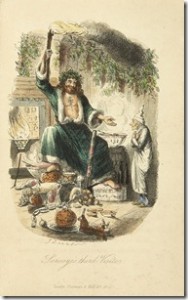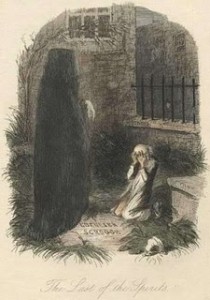 No better way to end than with Dickens’ own words, but the scores which accompany some of these films deserve mention, and I’ve selected three. Can’t do them all! None of the music is strikingly original, perhaps not even especially memorable. For the Sim version, Richard Addinsell interpolated numerous traditional songs and Christmas carols in his score but I confess I’m a sucker for “The Ballad of Barbara Allen,” presumed to be of distant Scottish origin. The tune is sprinkled throughout the film, coming to the fore when Scrooge, now reformed, is the unexpected guest at Fred’s (Brian Worth) Christmas party.
No better way to end than with Dickens’ own words, but the scores which accompany some of these films deserve mention, and I’ve selected three. Can’t do them all! None of the music is strikingly original, perhaps not even especially memorable. For the Sim version, Richard Addinsell interpolated numerous traditional songs and Christmas carols in his score but I confess I’m a sucker for “The Ballad of Barbara Allen,” presumed to be of distant Scottish origin. The tune is sprinkled throughout the film, coming to the fore when Scrooge, now reformed, is the unexpected guest at Fred’s (Brian Worth) Christmas party.
The appearance of Jacob Marley’s ghost, as I’ve implied, is my favorite part of these films, and an imaginative composer has a wonderful chance to work his magic in the long sequence, without dialogue or many sound effects, that leads up to it: Scrooge walking from the tavern through the snow to his front door, seeing the face of his dead partner in the doorknocker, entering the house, lighting a candle, climbing the stairs, entering his bedroom, locking the door, eating his gruel. Why, by the way, would Scrooge eat again, having just partaken at the tavern? Anyway . . .
 Addinsell’s music for the Sim account may be the best of the three I’ve selected: it’s not heavily orchestrated and has the right touch of mystery. For the 1938 Owen version, Franz Waxman’s score is a bit darker, an appropriate complement to the emphasis on dark shadows and an especially long crane shot up the staircase. Some years later, in 1984, Nick Bicât’s score in this sequence of the Scott movie is just a little overbearing, both in its over-emphasis of the supernatural portent and its loud volume; the music even seems overstressed by the color.
Addinsell’s music for the Sim account may be the best of the three I’ve selected: it’s not heavily orchestrated and has the right touch of mystery. For the 1938 Owen version, Franz Waxman’s score is a bit darker, an appropriate complement to the emphasis on dark shadows and an especially long crane shot up the staircase. Some years later, in 1984, Nick Bicât’s score in this sequence of the Scott movie is just a little overbearing, both in its over-emphasis of the supernatural portent and its loud volume; the music even seems overstressed by the color.
Maybe I can end with Dickens after all. What better way than the close of the novella itself, first published in 1843. It concludes, and appropriately so, most of the Christmas Carol films:
“Scrooge was better than his word [in giving Bob Cratchit a raise and assisting his needy family]. He did it all, and infinitely more; and to Tiny Tim, who did not die, he was a second father. He became as good a friend, as good a master, and as good a man, as the good old city knew, or any other good old city, town, or borough, in the good old world. . . . He had no further intercourse with Spirits, but lived upon the Total Abstinence Principle, ever afterward; and it was always said of him, that he knew how to keep Christmas well, if any man alive possessed the knowledge. May that be truly said of us, and all of us! And so, as Tiny Tim observed, God Bless Us, Every One!”
Drawings are by John Leech from the original first edition of A Christmas Carol in 1843.
0 thoughts to “A Christmas Carol”